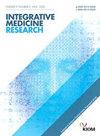Effect of acupressure on smoking cessation in young smokers with nicotine dependence: a mixed methods study
IF 3
4区 医学
Q2 INTEGRATIVE & COMPLEMENTARY MEDICINE
引用次数: 0
Abstract
Background
Acupressure has been widely used for quitting smoking for a long time in China. This study explores the feasibility and effects of acupressure on smoking cessation in young smokers with nicotine dependence to inform policy and decision-making.
Methods
This was a single group study using pre/post-test design. Participants received four weeks of auricular acupressure treatment, led by a registered acupuncturist. Smoking cravings, nicotine dependence, withdrawal symptoms, and cigarettes per day (CPD) were recorded before and after treatment. Changes in outcomes were analyzed at 2 weeks and 4 weeks using SPSS software version 22.0. Semi-structured interviews were conducted with participants to explore their experience and attitude towards auricular acupressure. Thematic analysis was applied to analyze the data.
Results
A total of 20 participants completed this study. A significant reduction was observed in smoking cravings (F = 11.02, P < 0.05), nicotine dependence (F = 11.09, P < 0.05), withdrawal symptoms (F = 11.19, P < 0.05), and CPD (F = 19.03, P < 0.05) over sessions. Additionally, withdrawal symptoms decreased significantly from 2 weeks to 4 weeks (P < 0.05) of acupressure treatment. Three inter-related themes emerged from interviews: personal and external resources, psychological and physical effects of acupressure, and satisfaction with acupressure for smoking cessation.
Conclusion
The quantitative and qualitative data suggest that acupressure maybe effective in decreasing nicotine dependence and smoking cravings. However, this was a pilot and single arm study, these effects need to be further verified. The study supports the feasibility and safety of introducing acupressure therapy for smoking cessation in young smokers.
穴位按压对尼古丁依赖的年轻吸烟者戒烟的影响:一项混合方法研究
穴位按摩在中国长期以来被广泛用于戒烟。本研究旨在探讨穴位按压对尼古丁依赖青少年戒烟的可行性和效果,为政策和决策提供依据。方法采用前/后测试设计的单组研究。参与者在注册针灸师的指导下接受为期四周的耳穴按摩治疗。治疗前后记录吸烟渴望、尼古丁依赖、戒断症状和每天吸烟(CPD)。使用SPSS 22.0软件分析2周和4周时结果的变化。采用半结构式访谈,探讨参与者对耳穴按压的体验和态度。采用主题分析法对数据进行分析。结果共20名受试者完成本研究。吸烟渴望显著降低(F = 11.02, P <;0.05)、尼古丁依赖(F = 11.09, P <;0.05)、戒断症状(F = 11.19, P <;0.05), CPD (F = 19.03, P <;0.05)。此外,戒断症状从2周到4周显著减少(P <;0.05)。访谈中出现了三个相互关联的主题:个人和外部资源,穴位按压的心理和身体效果,以及对穴位按压戒烟的满意度。结论定量和定性数据表明,穴位按压可有效降低尼古丁依赖和吸烟渴望。然而,这是一项试点和单组研究,这些效果需要进一步验证。本研究支持穴位按压疗法对年轻吸烟者戒烟的可行性和安全性。
本文章由计算机程序翻译,如有差异,请以英文原文为准。
求助全文
约1分钟内获得全文
求助全文
来源期刊

Integrative Medicine Research
Medicine-Complementary and Alternative Medicine
CiteScore
6.50
自引率
2.90%
发文量
65
审稿时长
12 weeks
期刊介绍:
Integrative Medicine Research (IMR) is a quarterly, peer-reviewed journal focused on scientific research for integrative medicine including traditional medicine (emphasis on acupuncture and herbal medicine), complementary and alternative medicine, and systems medicine. The journal includes papers on basic research, clinical research, methodology, theory, computational analysis and modelling, topical reviews, medical history, education and policy based on physiology, pathology, diagnosis and the systems approach in the field of integrative medicine.
 求助内容:
求助内容: 应助结果提醒方式:
应助结果提醒方式:


